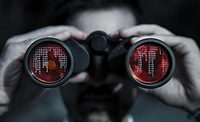Futuristic Security Innovations Solving Present-day Dilemmas
Cue the way-back machine, Sherman.

Cue the way-back machine, Sherman.
Back in time, I was getting a personal tour of historic computers in the Smithsonian by none other than the famous computer scientist Captain Grace Murray Hopper, who is said to have coined the term “computer bug.” I saw her famous nanosecond wires while listening to a mini-talk on how huge, expensive and limited were machines such as Mark 1, Eniac and Univac.
Welcome to today as I write this column on a 5.5-pound laptop with tons more processing power and memory than those first computing machines and costs less than what I spent watching the Chicago Cubs lose yet another ball game at Wrigley Field.
Someone once said that the future will be exactly like the past, only far more expensive. I beg to differ. Some advances, my laptop as one, come with a lower price tag, and there are also the intangibles.
A Walk-Around Video Solution
For instance, wearable video cameras are being tested by police officers, the latest in Rialto, Calif., after use in six other cities. The devices even have a 30-second pre-event video buffer. Police chiefs see a win-win: Officers know there is video evidence of an unfounded misconduct claim, and the public is protected from misconduct. So can wearables be the next craze for private security officers, too?
Solutions have gone one better. There is virtual guarding that jumps well beyond pre-programmed video guard tours. One firm, for example, monitors facilities remotely and there is even remote intervention including speaking to intruders, activating strobe lights and sirens, closing or locking gates and doors or even remotely activating safety systems and shutdowns. Such a solution can replace or augment on-site officers.
Another slice of this virtual pie, from UCIT, puts a big flat screen monitor and cameras behind a building’s unmanned reception desk. Displayed: An appropriately dressed “concierge” interacts remotely with a tenant or visitor while also providing a level of lobby security.
Dazzling technology and amazing applications seem to pop up every nanosecond.
But so do risks, both new and tradition.
Take retail security, for instance. The Centre for Retail Research and Professor Joshua Bamfield, its director, recently published a report that analyzes global retail crime and loss prevention trends going back to 2001.
Constant Level of Apprehensions
According to Bamfield, the number of retail thieves apprehended annually continues to be about six million. “And this is just the very tip of the iceberg,” he says. More than 78 percent of shrink is due to shoplifting by dishonest customers and fraud by employees.
Retailers have taken action in recent years. Of the 50 most stolen products, the number of items protected from theft by electronic article surveillance has increased from 60 percent in 2007 to 75 percent in 2011. The report points out that the role of loss prevention is increasingly providing strategic services to other areas of the business. So it is collaboration time with IT, store operations and marketing to minimize risk.
Most assuredly it is security video that has charted the biggest gains in retail and also with marketing and merchandizing.
Among recent advances:
“Voice of the Customer Analytics” has an enterprise intelligence focus, which goes beyond video. Still, within the menu of offerings: Nextiva video business intelligence applications to count people, monitor queues and assess merchandising and customer experience management in stores as well as surveillance analytics to provide perimeter protection and perform root cause analysis of shrinkage in stores.
At the National Retail Federation’s Loss Prevention Conference this month, the talk is hosted video surveillance. Video Surveillance-as-a-Service or VSaaS uses a video management system and a local network-attached storage device as redundant backup. A Plato’s Closet retailer in West Des Moines, Iowa, applies the approach for inventory control, loss mitigation and security.
In another example, Silverburn, Scotland’s newest shopping destination, boasts one of Europe’s most technically advanced security systems. Included is dome cameras, a combination of Surveyor PTZ and fixed dome models as well as Kollector digital video recorders.
Looking for a reprint of this article?
From high-res PDFs to custom plaques, order your copy today!





